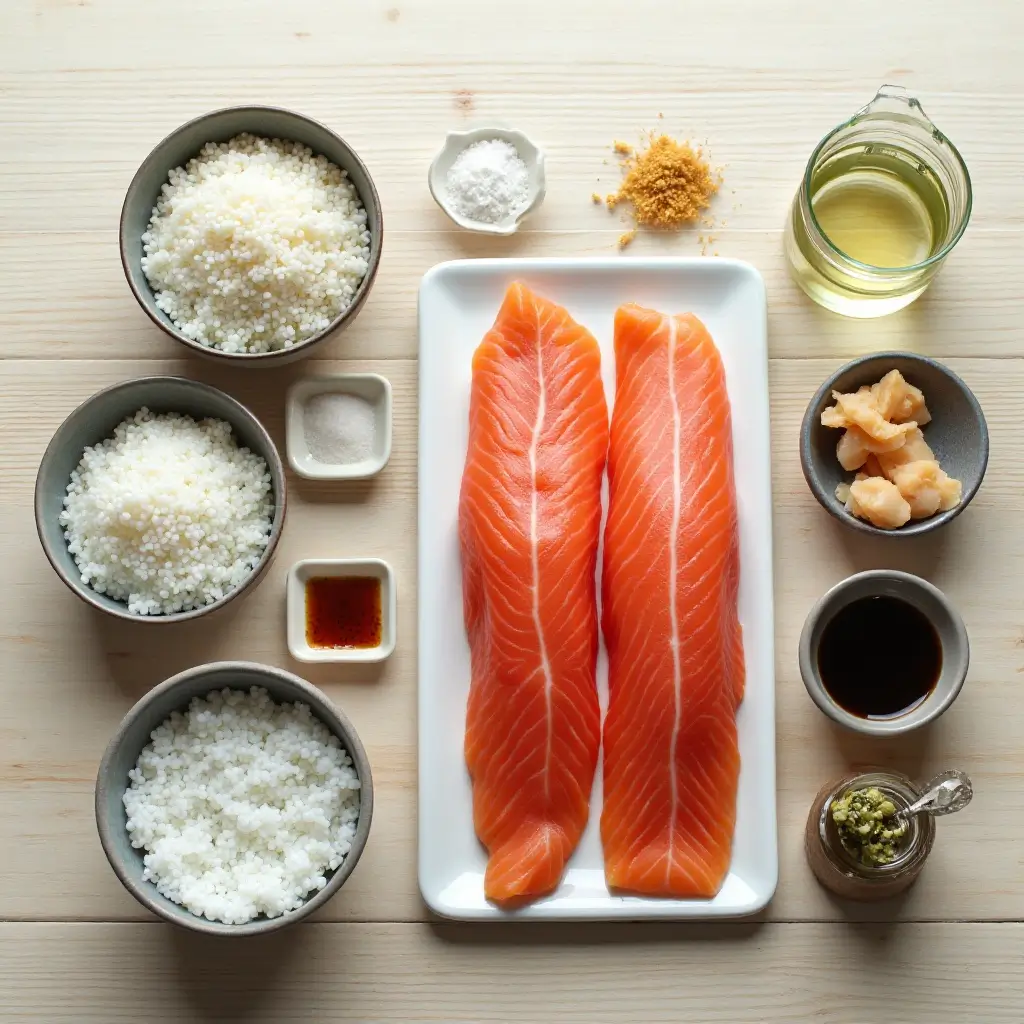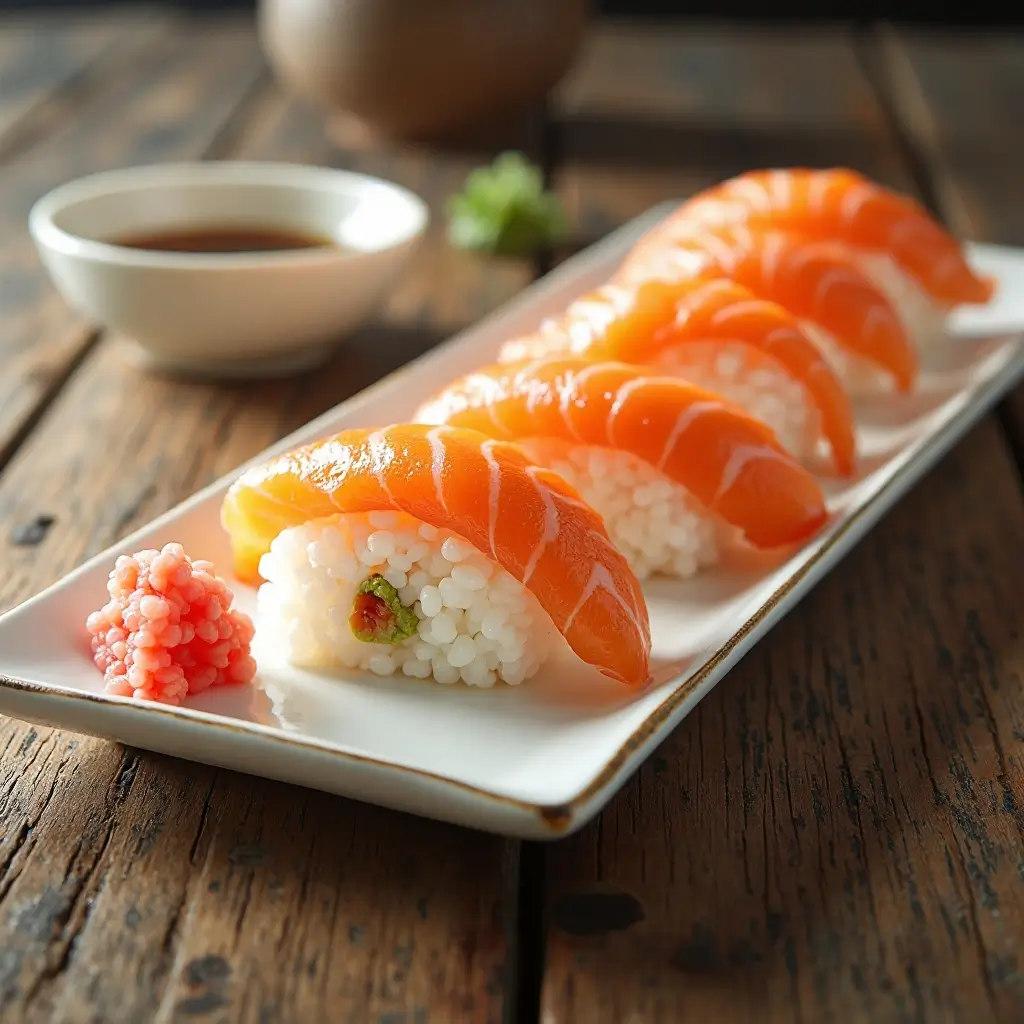Perfect Sake Nigiri Recipe – 20 Minutes
Imagine biting into a piece of buttery, melt-in-your-mouth salmon that’s been perfectly seasoned and delicately balanced on a pillow of perfectly seasoned sushi rice. That’s the magic of sake nigiri – a simple yet sophisticated Japanese delicacy that brings restaurant-quality sushi right to your kitchen.
This isn’t just any ordinary recipe; it’s your gateway to mastering one of Japan’s most beloved sushi preparations. What makes sake nigiri truly special is its beautiful simplicity – just two main ingredients creating harmony that’s both elegant and satisfying. You don’t need years of training or expensive equipment to create this masterpiece.
Table of Contents
In just 20 minutes, you can prepare fresh, restaurant-quality sake nigiri that will impress family and friends alike. Much like our popular California roll recipe, this dish proves that homemade sushi can be both achievable and absolutely delicious.
Get ready to embark on a culinary journey that will transform your appreciation for fresh fish and perfectly seasoned rice.
What is Sake Nigiri?
Ever wondered why this gorgeous piece of salmon-topped sushi is called “sake nigiri“? Well, “sake” means salmon in Japanese (not to be confused with the rice wine!), while “nigiri” literally translates to “hand-pressed.” So we’re talking about hand-pressed salmon sushi – pretty straightforward, right?
Legend has it that this style of sushi was invented by a clever chef who wanted to showcase the pure, unadulterated flavor of fresh fish. There’s truth to the saying that “the way to a man’s heart is through his stomach,” and sake nigiri certainly knows how to make hearts flutter with its simple elegance.
Ready to try your hand at this timeless Japanese classic? Let’s dive in and create some sushi magic together!
Why You’ll Love This Sake Nigiri
Fresh, High-Quality Ingredients
The star of this dish is undoubtedly the fresh salmon, which provides a rich, buttery texture that melts beautifully on your tongue. The clean, oceanic flavor of premium salmon paired with perfectly seasoned sushi rice creates an unforgettable taste experience that’s both satisfying and light.
Budget-Friendly Luxury
Making sake nigiri at home costs a fraction of what you’d pay at a sushi restaurant. A single piece of sake nigiri at restaurants can cost $3-5, but you can make 8-10 pieces at home for the same price. This means you can enjoy restaurant-quality sushi whenever the craving strikes without breaking the bank.

Simple Yet Sophisticated
What makes this recipe truly special is how such simple ingredients create something so elegant. The subtle sweetness of the vinegared rice complements the rich salmon perfectly, while a tiny dab of wasabi adds just the right amount of heat.
It’s similar to our popular tuna sashimi recipe in its simplicity, but the pressed rice adds a satisfying texture that makes it a complete meal. Why not roll up your sleeves and discover how easy it is to create this Japanese masterpiece in your own kitchen?
How to Make Sake Nigiri
Quick Overview
This sake nigiri recipe delivers restaurant-quality results with minimal effort and maximum flavor. The key to perfect nigiri lies in using the freshest salmon possible and properly seasoned sushi rice that’s been cooled to room temperature.
Preparation Time: 20 minutes (plus 30 minutes for rice cooling) Serving Size: 8-10 pieces Difficulty Level: Beginner-friendly
Key Ingredients for Sake Nigiri
For the Sushi Rice:
- 1 cup short-grain sushi rice
- 1¼ cups water
- 3 tablespoons rice vinegar
- 1 tablespoon sugar
- 1 teaspoon salt
For the Nigiri:
- 8 oz sushi-grade salmon fillet
- Wasabi paste (small amount)
- Pickled ginger (for serving)
- Soy sauce (for serving)

Step-by-Step Instructions
Step 1: Prepare the Sushi Rice Rinse the sushi rice under cold water until the water runs clear. Cook the rice according to package instructions or in a rice cooker. In a small saucepan, heat rice vinegar, sugar, and salt until dissolved. Once rice is cooked, transfer to a large bowl and gently fold in the vinegar mixture. Allow to cool to room temperature, covering with a damp towel.
Step 2: Prepare the Salmon Using a sharp knife, cut the salmon fillet into rectangular pieces about 3 inches long, 1 inch wide, and ¼ inch thick. Cut against the grain for the most tender texture. Pat each piece dry with paper towels.
Step 3: Wet Your Hands Fill a small bowl with water and add a splash of rice vinegar. This will prevent the rice from sticking to your hands during assembly.
Step 4: Shape the Rice Take about 1 tablespoon of sushi rice and gently form it into an oval shape using your palms. The rice should be compact but not overly pressed. Apply gentle pressure to ensure it holds its shape.
Step 5: Add Wasabi Place a tiny amount of wasabi (about the size of a grain of rice) on the center of each salmon piece. This adds a subtle heat that complements the fish beautifully.
Step 6: Assemble the Nigiri Gently place the salmon piece on top of the rice, pressing lightly to ensure it adheres. The salmon should drape slightly over the sides of the rice.
Step 7: Final Touch Arrange your sake nigiri on a clean plate and serve immediately with pickled ginger and soy sauce on the side.
What to Serve Sake Nigiri With
Sake nigiri pairs beautifully with traditional Japanese accompaniments. Serve alongside pickled ginger to cleanse the palate between pieces, and provide high-quality soy sauce for dipping. Consider adding other sushi varieties like tuna nigiri or cucumber rolls to create a complete sushi platter. Green tea or sake (the drink) complement the flavors perfectly. For a more substantial meal, add miso soup and a simple cucumber salad dressed with rice vinegar.

Top Tips for Perfecting Sake Nigiri
Choose the Right Salmon
Always use sushi-grade salmon from a reputable fishmonger. The fish should smell fresh and oceanic, never fishy. If sushi-grade isn’t available, you can freeze regular salmon at -4°F for 7 days to eliminate parasites, though this may affect texture slightly.
Master the Rice Temperature
The rice should be at room temperature, not cold or hot. Cold rice becomes hard and doesn’t mold well, while hot rice will cook the fish. If you’re in a hurry, spread the rice on a baking sheet to cool it faster.
Perfect Your Hand Technique
Keep your hands slightly damp but not soaking wet. Too much water will make the rice mushy, while dry hands will cause sticking. Practice the gentle pressing motion – you want the rice to hold together without being compressed into a hard ball.
Timing is Everything
Assemble nigiri just before serving. The rice will dry out if left sitting too long, and the fish may warm up and lose its ideal texture.
Storing and Reheating Tips
Sake nigiri is best enjoyed immediately after preparation, but if you must store leftovers, wrap each piece individually in plastic wrap and refrigerate for no more than 24 hours. The rice will harden in the refrigerator, so allow it to come to room temperature for 10-15 minutes before eating.
Never freeze assembled nigiri, as this will destroy the texture of both the rice and fish. However, you can prepare extra sushi rice and store it covered at room temperature for up to 4 hours. If you have leftover salmon, it can be refrigerated for up to 2 days and used for sashimi or other preparations.
For the best experience, prepare only what you plan to eat immediately, as nigiri doesn’t reheat well and is meant to be enjoyed fresh.
Frequently Asked Questions
Can I use regular salmon from the grocery store?
Only use salmon specifically labeled as “sushi-grade” or “sashimi-grade.” Regular salmon may contain parasites that are eliminated during cooking but remain dangerous when consumed raw.
How do I know if my salmon is fresh enough?
Fresh salmon should have a bright orange-pink color, firm texture, and smell like the ocean. Avoid fish that smells fishy, has a slimy texture, or appears dull in color.
Can I make the rice ahead of time?
Yes, sushi rice can be prepared up to 4 hours in advance. Keep it covered with a damp towel at room temperature. Don’t refrigerate it, as this will make it hard and difficult to work with.
What’s the difference between nigiri and sashimi?
Nigiri consists of fish over seasoned rice, while sashimi is just the fish served without rice. Both use the same quality fish, but nigiri is more filling due to the rice component.
How much wasabi should I use?
Use just a tiny amount – about the size of a grain of rice. Too much wasabi will overpower the delicate salmon flavor. You can always add more when eating.
Can I substitute the salmon with other fish?
Absolutely! Tuna, yellowtail, and sea bass all work wonderfully. Just ensure whatever fish you choose is sushi-grade and properly prepared.
Nutritional Information
| Nutrient | Per 2 Pieces |
|---|---|
| Calories | 180 |
| Protein | 16g |
| Carbohydrates | 22g |
| Fat | 4g |
| Omega-3 Fatty Acids | 1.2g |
| Sodium | 280mg |
| Fiber | 0g |
| Sugar | 2g |
Pro Chef Secrets for Restaurant-Quality Results
The Rice Water Test: Your sushi rice is perfectly seasoned when a grain tastes slightly tangy but not sour. The rice should glisten but not be wet or sticky.
The Salmon Slice Technique: Always slice salmon against the grain using a sharp knife in one smooth motion. Multiple cuts create a ragged edge that doesn’t look professional.
Temperature Control: Keep your workspace cool. Warm temperatures make the rice sticky and can cause the salmon to become too soft to handle properly.
The Gentle Press: When forming nigiri, think of it as gently cupping the ingredients together rather than squeezing. The rice should hold its shape but still feel light and airy.
This sake nigiri recipe opens up a whole world of homemade sushi possibilities. Once you master this technique, you’ll find yourself experimenting with different fish varieties and even creating your own sushi combinations. The satisfaction of creating restaurant-quality sushi at home is unmatched, and your family and friends will be amazed at your newfound culinary skills. Remember, practice makes perfect, so don’t be discouraged if your first attempts aren’t picture-perfect – even professional sushi chefs spent years perfecting their craft!
Have you tried making sake nigiri at home? Share your experience in the comments below, and don’t forget to tag us on social media with your beautiful creations!
